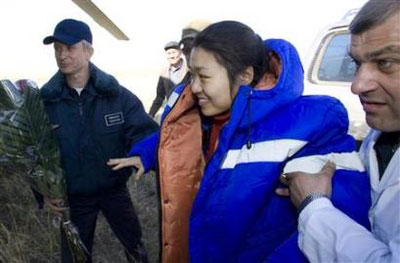Scary landing tests Korean astronaut
(Agencies)
Updated: 2008-04-22 09:14
Updated: 2008-04-22 09:14
Star City, Russia - Only the cool composure of her crewmates calmed South Korea's first astronaut when she saw flames swirling around their capsule during an unusually steep descent to Earth, she said on Monday.
 Ground crew help South Korea's first astronaut Yi So-Yeon after the Soyuz space capsule she was in landed in northern Kazakhstan April 19, 2008. [Agencies] |
Yi So-yeon, a nanotechnology engineer from Seoul, returned to Earth on Saturday after 11 days aboard the International Space Station (ISS), along with Russian cosmonaut Yuri Malenchenko and US astronaut Peggy Whitson.
A technical glitch turned a routine return to Earth into a sharper than usual descent that tested the crew members' stamina and nerve. They landed in the Kazakh steppes about 420km (260 miles) wide of their target.
"During the descent there was some kind of fire outside the Soyuz capsule because we were going through the atmosphere," Yi said.
"At first I was scared, but the two other guys looked okay, so I tried to look okay too."
Yi smiled and joked her way through a 30-minute news briefing at Star City, the wooded, Soviet-era cosmonaut training centre on the edge of Moscow.
By contrast, Malenchenko and Whitson looked tired and thin after nearly six months in space. Their answers were short and Whitson needed support to balance when she walked.
The 29-year-old Yi has become a sensation in South Korea since take-off but she brushed this aside and said she has had little contact with friends or family since returning.
"In fact, they are the heroes right now," Yi said, referring to Malenchenko and Whitson. "I'm just a beginner and a little ashamed to say that I am a hero."
She did, though, relate a more light-hearted incident on the ISS.
"I sang 'Fly Me to the Moon'," Yi said about the 1950s pop song. "It's my favorite song from university although at that time I didn't know I would be an astronaut."
The capsule's so-called "ballistic" re-entry exposed the crew to twice the usual gravitational forces. The flames Yi described may have been caused by friction heating the capsule as it fell through the atmosphere.
Whitson told reporters that Saturday's ballistic landing, was irregular but not an emergency.
"The Soyuz has been through its history very reliable, there has obviously been some issue in the last couple of descents which went ballistic, but I'm sure the engineers will determine what the problems are and get them fixed," she said.
In October, a Soyuz capsule carrying Malaysia's first space tourist touched down about 200 km (125 miles) off course in a similar ballistic landing caused by a technical glitch.
The Soyuz is the world's longest-serving manned space capsule. An early version of the craft, the Vostok, carried the first person into space in 1961.
Whitson, 48, has become the American with the longest amount of cumulative time in space with 377 days.
|
||
|
||
|
|
|
|